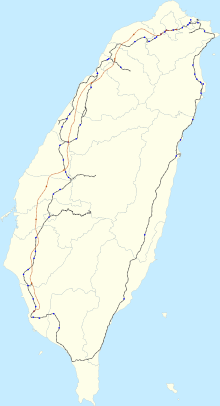| Taiwan | |||||
|---|---|---|---|---|---|
| Operation | |||||
| National railway | Taiwan Railway | ||||
| Major operators | Taiwan High Speed Rail | ||||
| Statistics | |||||
| Ridership | 287 million[1] (2016) | ||||
| Passenger km | 21.5 billion[1] (2016) | ||||
| System length | |||||
| Total | 2,033 kilometres (1,263 mi) | ||||
| Double track | 107 km (66 mi) | ||||
| Electrified | 1,233 km (766 mi) | ||||
| High-speed | 352 km (219 mi) | ||||
| Track gauge | |||||
| Main | 1,067 mm (3 ft 6 in) | ||||
| High-speed | 1,435 mm (4 ft 8+1⁄2 in) | ||||
| 1,067 mm (3 ft 6 in) | 1,065 kilometres (662 mi) | ||||
| 1,435 mm (4 ft 8+1⁄2 in) | 513 kilometres (319 mi) | ||||
| Features | |||||
| Longest tunnel | Xinguanyin Tunnel 10.3071 kilometres (6.4045 mi) | ||||
| Longest bridge | THSR Changhua-Kaohsiung Viaduct 157.317 kilometres (97.752 mi) | ||||
| |||||
Rail transport in Taiwan consists of 2,025 kilometres (1,258 mi) (as of 2015) of railway networks.[2] Though no longer as dominant as it once was, rail transport is an extremely important form of transportation in Taiwan due to high population density, especially along the densely populated western corridor. In 2016, over 1.09 billion passengers traveled by rail in Taiwan, averaging 2.99 million passengers per day.[3]
The railways of Taiwan include conventional rail, rapid transit systems, and high-speed rail, as well as specialized railways for tourists and industry. Taiwan Railways Administration is an associate member and Taiwan High Speed Rail is an active member of the International Union of Railways (UIC), even though Taiwan does not have state membership.
Rail transport was introduced to Taiwan in 1891 during its late Qing era. Push car railways were brought to Taiwan during Japanese rule and were in general service from 1895 to the late 1940s.
All railway services are located in the main island of Taiwan. Outer islands including Penghu, Kinmen, and Matsu Islands do not have railways.
- ^ a b 鐵路重要參考指標統計表. Ministry of Transportation and Communication, ROC (in Chinese (Taiwan)). Retrieved 1 December 2017.
- ^ TRA+THSR+MRTs only
- ^ "Table 2-1 Passenger Traffic of Railway in Taiwan Area". Ministry of Transportation and Communications. Retrieved 1 August 2017.
